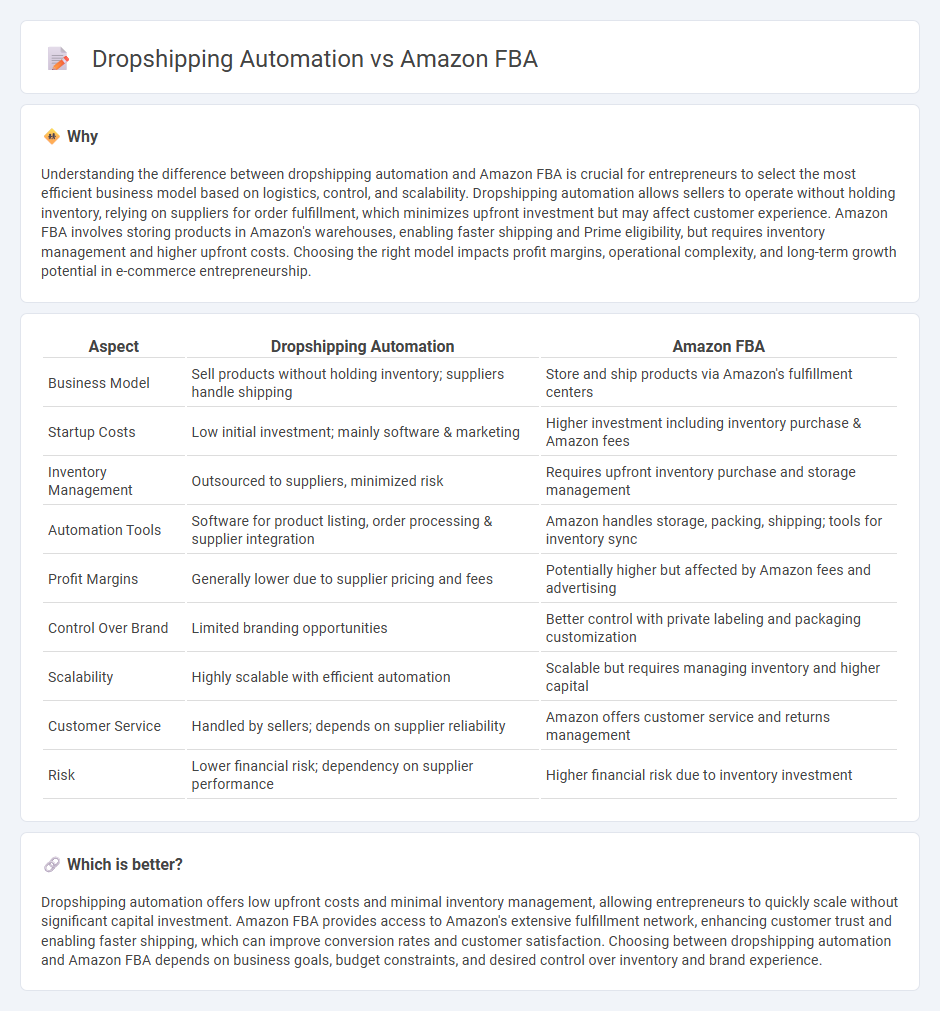
Dropshipping automation streamlines order fulfillment by partnering directly with suppliers, minimizing upfront inventory costs and enabling rapid product scaling. Amazon FBA offers robust logistics support, leveraging Amazon's warehouse network for fast shipping and trusted customer service, but requires inventory investment and management. Explore the key differences between dropshipping automation and Amazon FBA to optimize your entrepreneurial strategy.
Why it is important
Understanding the difference between dropshipping automation and Amazon FBA is crucial for entrepreneurs to select the most efficient business model based on logistics, control, and scalability. Dropshipping automation allows sellers to operate without holding inventory, relying on suppliers for order fulfillment, which minimizes upfront investment but may affect customer experience. Amazon FBA involves storing products in Amazon's warehouses, enabling faster shipping and Prime eligibility, but requires inventory management and higher upfront costs. Choosing the right model impacts profit margins, operational complexity, and long-term growth potential in e-commerce entrepreneurship.
Comparison Table
| Aspect | Dropshipping Automation | Amazon FBA |
|---|---|---|
| Business Model | Sell products without holding inventory; suppliers handle shipping | Store and ship products via Amazon's fulfillment centers |
| Startup Costs | Low initial investment; mainly software & marketing | Higher investment including inventory purchase & Amazon fees |
| Inventory Management | Outsourced to suppliers, minimized risk | Requires upfront inventory purchase and storage management |
| Automation Tools | Software for product listing, order processing & supplier integration | Amazon handles storage, packing, shipping; tools for inventory sync |
| Profit Margins | Generally lower due to supplier pricing and fees | Potentially higher but affected by Amazon fees and advertising |
| Control Over Brand | Limited branding opportunities | Better control with private labeling and packaging customization |
| Scalability | Highly scalable with efficient automation | Scalable but requires managing inventory and higher capital |
| Customer Service | Handled by sellers; depends on supplier reliability | Amazon offers customer service and returns management |
| Risk | Lower financial risk; dependency on supplier performance | Higher financial risk due to inventory investment |
Which is better?
Dropshipping automation offers low upfront costs and minimal inventory management, allowing entrepreneurs to quickly scale without significant capital investment. Amazon FBA provides access to Amazon's extensive fulfillment network, enhancing customer trust and enabling faster shipping, which can improve conversion rates and customer satisfaction. Choosing between dropshipping automation and Amazon FBA depends on business goals, budget constraints, and desired control over inventory and brand experience.
Connection
Dropshipping automation and Amazon FBA both streamline e-commerce fulfillment by reducing manual tasks and optimizing inventory management. Dropshipping automation leverages software to handle order processing and supplier coordination, while Amazon FBA centralizes storage and shipping through Amazon's warehouses. Together, these systems enhance scalability, improve delivery speed, and minimize overhead for entrepreneurs in online retail.
Key Terms
Inventory Management
Amazon FBA automates inventory management by storing products in fulfillment centers, handling packaging, and shipping, which reduces seller workload and ensures faster delivery times. Dropshipping automation relies on real-time inventory syncing with suppliers, minimizing stockouts but requiring continuous monitoring to avoid order fulfillment issues. Explore more to understand which inventory management approach suits your e-commerce business goals best.
Fulfillment Process
Amazon FBA automates order fulfillment by storing inventory in Amazon's warehouses, ensuring fast shipping and reliable customer service, while dropshipping automation relies on third-party suppliers to handle inventory and shipping directly to customers. FBA benefits from Amazon Prime eligibility and streamlined returns, whereas dropshipping requires managing multiple supplier integrations and potential shipping delays. Explore the detailed differences in fulfillment processes to choose the best strategy for your e-commerce business.
Profit Margin
Amazon FBA offers higher profit margins due to bulk purchasing and Prime shipping benefits, while dropshipping automation relies on lower upfront costs but experiences thinner margins from supplier fees and increased competition. FBA sellers benefit from Amazon's fulfillment infrastructure and customer trust, leading to enhanced scalability and better control over inventory. Explore detailed strategies to maximize your earnings with Amazon FBA and dropshipping automation.
Source and External Links
Fulfillment by Amazon (FBA) - Amazon FBA is a program that lets sellers outsource order fulfillment to Amazon, which handles storage, packing, shipping, customer service, and returns, enabling sellers to offer fast two-day Prime shipping and potentially increase sales and business growth globally.
Amazon FBA for beginners - Amazon FBA works by enrolling products into fulfillment centers, then Amazon manages inventory, picks, packs, ships the orders, and provides customer service, with sellers deciding whether to fulfill all or part of their orders through FBA, including support for multi-channel fulfillment.
How to Sell on Amazon FBA for Beginners - 2024 Guide | Jungle Scout - Amazon FBA helps sellers scale by storing, packaging, and shipping products for them, supporting various business models like private label, wholesale, and dropshipping, requiring only a product, seller account, and means to deliver products to customers.
 dowidth.com
dowidth.com